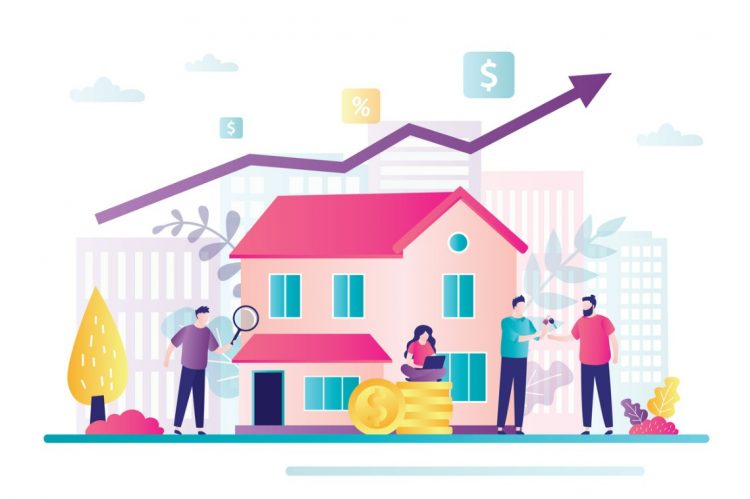The S&P CoreLogic Case-Shiller U.S. National Home Price NSA Index, covering all nine U.S. census divisions, reported a 6.4% annual gain for February, up from a 6.0% rise in the previous month. The data from the leading measure of U.S. home prices released April 30 shows that 18 out of the 20 major metro markets reported month-over-month price increases.
The 10-City Composite showed an increase of 8.0%, up from a 7.4% increase in the previous month. The 20-City Composite posted a year-over-year increase of 7.3%, up from a 6.6% increase in the previous month. San Diego continued to report the highest year-over-year gain among the 20 cities with an 11.4% increase in February, followed by Chicago and Detroit, with increases of 8.9%. Portland, while still holding the lowest rank after reporting two consecutive months of the smallest year-over-year growth, had a significant annual increase of 2.2% in February.
“Following last year’s decline, U.S. home prices are at or near all-time highs,” stated Brian D. Luke, Head of Commodities, Real & Digital Assets at S&P Dow Jones Indices in a release. “Our National Composite rose by 6.4% in February, the fastest annual rate since November 2022. Our 10- and 20-City Composite indices are currently at all-time highs. For the third consecutive month, all cities reported increases in annual prices, with four currently at all-time highs: San Diego, Los Angeles, Washington, D.C., and New York. On a seasonal adjusted basis, our National, 10- and 20- City Composite indices continue to break through previous all-time highs set last year.”
According to the report, the U.S. National Index, the 20-City Composite, and the 10-City Composite all rose for the first time since October 2023, showing pre-seasonality adjustment increases of 0.6%, 0.9% and 1.0%, respectively.
After seasonal adjustment, the U.S. National Index posted a month-over-month increase of 0.4%, while the 20-City and the 10-City Composite both reported month-over-month increases of 0.6%.
“As with many economic indicators, the road to normalizing housing markets remains windy. While home sales and inventories are improving over last year’s bottom, higher mortgage rates continue to challenge affordability and keep many potential buyers on the sidelines,” said Dr. Selma Hepp, Chief Economist at CoreLogic. “Still, given the persistent imbalance between buyers and sellers, home-price growth remains solid and monthly gains march higher despite slowing of annual acceleration which simply reflects comparison with particularly strong gains in spring of 2023.”
Related: Dr. Happ will be providing an economic ‘State of the Union’ at RISMedia’s CEO & Leadership Exchange on Sept. 4 at the Mayflower Hotel in Washington, D.C. Learn more and watch for details here.
“Since the previous peak in prices in 2022, this marks the second time home prices have pushed higher in the face of economic uncertainty,” noted Luke. “The first decline followed the start of the Federal Reserve’s hiking cycle. The second decline followed the peak in average mortgage rates last October. Enthusiasm for potential Fed cuts and lower mortgage rates appears to have supported buyer behavior, driving the 10- and 20- City Composites to new highs.
“The Northeast region, which includes Boston, New York, and Washington, D.C., ranks as the best-performing market for over the last half year. As remote work benefitted smaller (and sunnier markets) in the first part of the decade, return to office may be contributing to outperformance in larger metropolitan markets in the Northeast,” according to Luke.
“San Diego has been the best-performing market following the trough in home prices observed in early 2023. With Los Angeles rising for 13 consecutive months to record another new high, Southern California has outperformed its surrounding neighbors. San Francisco has dropped 12% since its peak, while Phoenix and Las Vegas have dropped 6% and 4.5%, respectively.”
“With all markets increasing on an annual basis, similar performance was observed in the monthly return data. Eighteen markets experienced an uplift in February. Tampa experienced a decline of 0.3% while Seattle has the largest monthly gain of 2.3%,” said Luke.
Realtor.com Senior Economic Research Analyst Hannah Jones commented:
“The latest S&P CoreLogic Case-Shiller Index showed prices trending higher through February. The national, 10- and 20-city composites posted annual price gains ranging from 6.4% to 8.0%, a pick-up over the gains seen in the prior month, which ranged from 6.0% to 7.4%.This month’s index data tracks December, January and February, a period through which mortgage rates dipped to 6.6%, then climbed back towards 7.0%. Home inventory increased 14.8% in February, but remained nearly 40% lower than pre-pandemic levels. Home supply improved annually starting in November 2023, but buyers still saw relatively fewer homes for sale compared to pre-pandemic, which prevented home prices from easing. Existing home sales increased 9.5% in February as buyers enjoyed more available inventory, despite still-climbing prices.
“The Midwest and Northeast remained popular with homebuyers, which kept prices climbing annually in the regions. Both the February Hottest Housing Markets and the February Rental Report highlighted this trend as well. Southern markets saw slower price growth as relatively abundant inventory relieved some price pressure in the region. The West region continues to see price gains, with San Diego reporting the highest annual price growth (+11.4%) among the 20 cities tracked, followed by Chicago (+8.9%) and Detroit (+8.9%). Portland saw the slowest growth with prices climbing just 2.2% annually. Prices continue to rise across the U.S. and recent research found that it was more affordable to rent a home than to purchase a home in all 50 of the country’s largest metro areas.
“Seller activity continued to pick up into the early spring, climbing 23.5% year-over-year in March, in part due to a 15.5% increase in new listings in the month. Affordable inventory (homes priced between $200,000 and $350,000) saw an even more significant 30.5% increase annually in March. Buyers have been eagerly awaiting more favorable housing conditions, and an increase in for-sale inventory is a step in the right direction. However, home prices continued to increase annually in many areas across the U.S. which, coupled with mortgage rates near 7%, means that purchasing a home remains challenging for many buyers,” Jones concluded.












